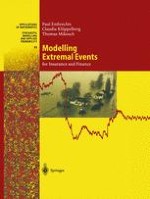Both in insurance and in finance applications, questions involving extremal events (such as large insurance claims, large fluctuations in financial data, stock market shocks, risk management, ...) play an increasingly important role. This book sets out to bridge the gap between the existing theory and practical applications both from a probabilistic as well as from a statistical point of view. Whatever new theory is presented is always motivated by relevant real-life examples. The numerous illustrations and examples, and the extensive bibliography make this book an ideal reference text for students, teachers and users in the industry of extremal event methodology.

